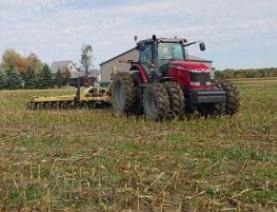By Glen Arnold
Some Ohio livestock producers will be looking to apply manure to farm fields frozen enough to support application equipment. This is due to the wet weather in later October, November, and December that also stretched out the crop harvest season. Permitted farms are not allowed to apply manure in the winter unless it is an extreme emergency, and then movement of manure to other suitable storage is usually the selected alternative. Thus, this article is for non-permitted livestock operations.

Incorporate manure to prevent run-off
In the Grand Lake St Marys watershed, the winter manure application ban from December 15th to March 1st is still in effect. Thus, no manure application would normally be allowed from now until March 1st.
In the Western Lake Erie Basin (WLEB) watershed, the surface application of manure to frozen and snow-covered soils require there to be a growing crop in the field. This could be a pasture, alfalfa, clover, ryegrass or a rape crop. There must be enough vegetation visible to provide a 90% cover of residue and growing vegetation. Radishes and oats would not qualify as a growing crop as both are typically winter killed. Manure can be applied to fields without growing crops if the manure is incorporated at the time of application or incorporated within 24 hours of application.
The rainfall rule for surface manure application in the WLEB is a weather forecast saying “not greater than a 50% chance of a half inch or more of rain in the next 24 hours”. It is advisable to print out the weather forecast when you start applying manure, so you have the needed proof if an unexpected storm drenches the area. Weather.gov is the most commonly accepted website for this forecast. On this web page, you can type in the zip code for a seven-day forecast. On the lower right-hand side of the seven-day forecast page, is an hourly weather forecast that will provide a 48-hour weather forecast graph.
Winter manure application rates should follow the Natural Resource Conservation Service 590 standards, which limit solid manure application amounts to five tons per acre and liquid manure application amounts to 5,000 gallons per acre. These have 200 foot setback distances from ditches, streams and creeks and must be on slopes of less than 6% and less than 20 acre areas in size without additional buffers. These setbacks exist because as snow melts, it can carry manure to streams and ditches. These 200 foot setback distances apply to both liquid and solid manure application. In recent years there have been several fines levied against livestock producers applying manure too close to ditches and streams.
For liquid manure applicators, examine fields for tile blowouts, monitor tile outlets before, during, and after manure application and any other situations that might allow manure to reach surface waters. If a cover crop has been planted, talk to the local Soil and Water Conservation District to determine of the cover crop has sufficient growth to meet the requirements.
Source : osu.edu